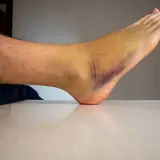Generally pain, swelling and bruising are common for an ankle sprain. The amount of swelling and bruising can sometimes be very alarming to people. Redness and heat are also quite common at the injury site.
Touching the area or attempting to move the injured site typically will cause pain. A notable limp is expected on the injured limb.
In some ankle injury conditions the bones that make up the ankle are allowed to move in such a way that a bone deformity called talar dome injury occurs. This condition is frequently missed on initial exam (even with X-rays), and the person suffers from a long lasting pain that is described as “deep in the ankle”. Ankle pain lasting greater than 4 months post injury needs to be evaluated for this condition.

